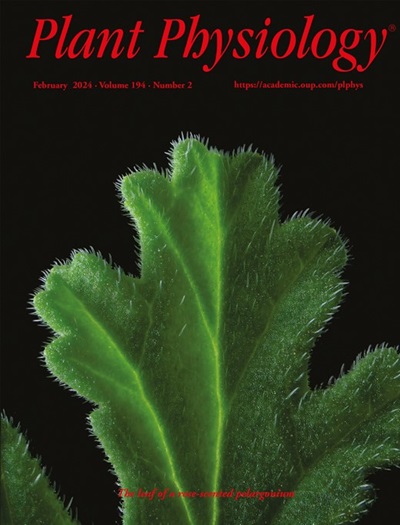构建非编码rna介导的代谢调控网络,探索番茄育种中的代谢变异
IF 6.9
1区 生物学
Q1 PLANT SCIENCES
引用次数: 0
摘要
番茄(Solanum lycopersicum)是一种富含次生代谢产物的重要经济作物,是研究次生代谢的模式生物。然而,关于非编码rna (ncRNAs)如何调节番茄代谢物积累的研究有限。在此,我们鉴定并鉴定了3个番茄亚群中的418个mirna,分别是:细粒茄(Solanum pinpinellifolium, SP)、蜡状茄(Solanum lycopersicum var. cerasformme, SLC)和番茄变种茄(Solanum lycopersicum var. lycopersicum, SLL)。值得注意的是,索拉姆(Solanum pimpinellifolium)基因组中缺失的mirna数量最多,其靶点与糖代谢有关。接下来,我们确定了133个在驯化过程中上调的mirna;它们的靶基因与植物的发育和形态发生有关。此外,还鉴定和鉴定了2938种长链非编码rna (lncrna),其中基因间lncrna是最丰富的类型(占所有lncrna的70.2%)。从多个组织中鉴定出280种代谢物(黄酮类化合物、甾体糖生物碱等),各组织中甾体糖生物碱含量与驯化状态相关。最后,我们构建了一个ncrna介导的番茄代谢调控网络,包括369对lncRNA-miRNA、5659对miRNA-mRNA和136599对mrna代谢物。我们发现miR172亚型靶向一个参与类黄酮糖基化的udp -糖基转移酶(SlUGT71T212),我们验证了miR172a-SlUGT71T212模块在柚皮素o -糖苷形成中的作用。我们的研究提供了一个全面而有价值的番茄ncrna及其代谢物数据集。ncrna介导的代谢调控网络为阐明番茄育种过程中代谢变异及其调控提供了有益的理论资源。本文章由计算机程序翻译,如有差异,请以英文原文为准。
Construction of a non-coding RNA-mediated metabolic regulatory network to explore metabolic variation in tomato breeding
Tomato (Solanum lycopersicum), an economically important crop rich in secondary metabolites, serves as a model organism for studying secondary metabolism. However, research into how non-coding RNAs (ncRNAs) regulate metabolite accumulation in tomato is limited. Here, we identified and characterized 418 miRNAs in three tomato subgroups: Solanum pimpinellifolium (SP), Solanum lycopersicum var. cerasiforme (SLC), and Solanum lycopersicum var. lycopersicum (SLL). Notably, the Solanum pimpinellifolium genome exhibited the highest number of missing miRNAs, with targets linked to sugar metabolism. Next, we identified 133 miRNAs that were up-regulated during domestication; their target genes were associated with plant development and morphogenesis. Additionally, 2,938 long non-coding RNAs (lncRNAs) were identified and characterized, with intergenic lncRNAs being the most abundant type (70.2% of all lncRNAs). A total of 280 metabolites were identified from multiple tissues (flavonoids, steroidal glycoalkaloids, etc), and the steroidal glycoalkaloid content of all tissues was associated with domestication status. Finally, we constructed a ncRNA-mediated metabolic regulatory network for tomato, which included 369 lncRNA-miRNA pairs, 5,659 miRNA-mRNA pairs, and 136,599 mRNA-metabolite pairs. We found that miR172 isoforms target a UDP-glycosyltransferase (SlUGT71T212), which is involved in the glycosylation of flavonoids, and we validated the role of the miR172a-SlUGT71T212 module in the formation of naringenin-O-glycoside. Our study provides a comprehensive and valuable dataset of ncRNAs and metabolites in tomato. The ncRNA-mediated metabolic regulatory network is a useful theoretical resource for elucidating metabolic variation and its regulation during tomato breeding.
求助全文
通过发布文献求助,成功后即可免费获取论文全文。
去求助
来源期刊

Plant Physiology
生物-植物科学
CiteScore
12.20
自引率
5.40%
发文量
535
审稿时长
2.3 months
期刊介绍:
Plant Physiology® is a distinguished and highly respected journal with a rich history dating back to its establishment in 1926. It stands as a leading international publication in the field of plant biology, covering a comprehensive range of topics from the molecular and structural aspects of plant life to systems biology and ecophysiology. Recognized as the most highly cited journal in plant sciences, Plant Physiology® is a testament to its commitment to excellence and the dissemination of groundbreaking research.
As the official publication of the American Society of Plant Biologists, Plant Physiology® upholds rigorous peer-review standards, ensuring that the scientific community receives the highest quality research. The journal releases 12 issues annually, providing a steady stream of new findings and insights to its readership.
 求助内容:
求助内容: 应助结果提醒方式:
应助结果提醒方式:


